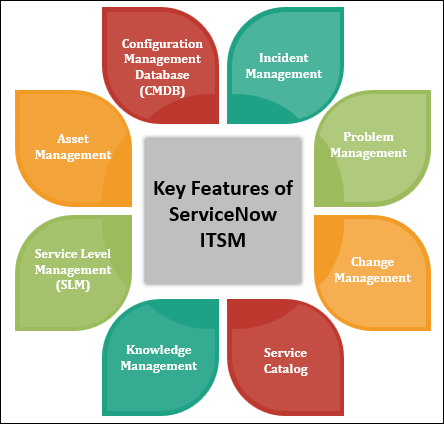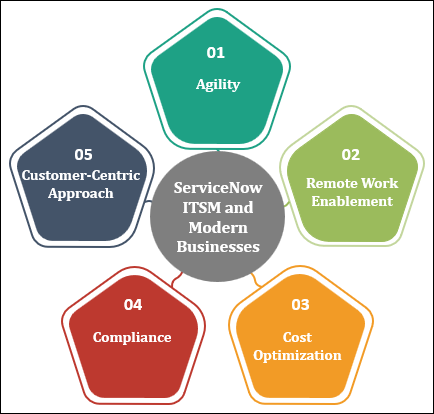ITSM SERVICENOW MODULE
The ServiceNow IT Service Management (ITSM) module is a cornerstone of modern organizations' efforts to streamline and enhance their IT service operations. In today's digitally driven world, where technology underpins nearly every aspect of business, efficient IT service management is crucial. ITSM ServiceNow provides a comprehensive suite of tools and functionalities designed to optimize IT service delivery and support.

This article delves into the ITSM ServiceNow module, exploring its key features, advantages, implementation strategies, and its profound impact on contemporary businesses. ITSM ServiceNow encompasses a wide range of critical functions, from incident and problem management to service request fulfillment and asset tracking. These features empower organizations to resolve issues promptly, minimize downtime, and align IT services with business needs.
Understanding ITSM ServiceNow
ITSM ServiceNow is a comprehensive suite of tools and functionalities designed to support and enhance IT service delivery and management within organizations. It encompasses a wide range of IT service-related activities, from incident management and problem resolution to change management and service request fulfillment. ITSM ServiceNow provides a structured framework to streamline these processes, thereby improving efficiency, reducing downtime, and enhancing user satisfaction.
Key Features Of ITSM ServiceNow
- Incident Management: This feature helps IT teams to efficiently record, track, and resolve incidents. It facilitates a systematic approach to identify, prioritize, and resolve issues, ensuring minimal disruption to business operations.
- Problem Management: ITSM ServiceNow offers problem management capabilities to help organizations identify the root causes of recurring incidents. By addressing underlying issues, it aims to prevent future disruptions.
- Change Management: Effective change management is crucial for implementing new technologies and processes smoothly. ITSM ServiceNow provides tools to plan, assess, and execute changes while minimizing risks.
- Service Catalog: The service catalog allows organizations to create a user-friendly interface for requesting IT services. It simplifies the process of submitting and tracking service requests.
- Knowledge Management: Knowledge management capabilities enable the creation and sharing of IT knowledge across the organization. This empowers users to resolve common issues on their own, reducing the burden on IT support.
- Service Level Management (SLM): SLM tools enable organizations to define, monitor, and meet service level agreements (SLAs). This ensures that IT services align with business expectations.
- Asset Management: ITSM ServiceNow provides asset tracking and management capabilities, allowing organizations to keep tabs on their IT assets, optimize resource allocation, and control costs.
- Configuration Management Database (CMDB): The CMDB is a central repository that stores information about all IT assets and their relationships. It helps in understanding the impact of changes and incidents on the IT environment.
Benefits Of ITSM ServiceNow
- Improved Service Delivery: ITSM ServiceNow streamlines processes, reduces manual effort, and enhances automation, leading to faster and more reliable service delivery.
- Enhanced User Experience: The service catalog and knowledge management features empower users to access IT services and solutions more easily, resulting in higher satisfaction levels.
- Increased Efficiency: IT teams can work more efficiently by automating routine tasks, which frees up time for strategic initiatives and innovation.
- Better Visibility And Reporting: ITSM ServiceNow provides real-time insights and reporting capabilities, enabling organizations to make data-driven decisions and optimize IT operations.
- Risk Reduction: The change and problem management functionalities help organizations identify and mitigate risks associated with IT changes and recurring issues.
Implementing ITSM ServiceNow
Implementing ITSM ServiceNow requires careful planning and execution. Here are the key steps involved:
- Define Objectives: Clearly define your organization's goals and objectives for implementing ITSM. Determine what you want to achieve in terms of service quality, efficiency, and user satisfaction.
- Assess Current Processes: Evaluate your existing IT service management processes to identify areas that need improvement. This assessment will help you tailor ITSM ServiceNow to your organization's specific needs.
- Design And Customize: ITSM ServiceNow is highly customizable. Design workflows, configure forms, and create automation rules to align the platform with your processes and requirements.
- Data Migration: Migrate relevant data from your legacy systems to ITSM ServiceNow, ensuring data accuracy and integrity.
- Training And Change Management: Train your IT staff and end-users on how to use the platform effectively. Implement change management strategies to ensure a smooth transition.
- Testing: Thoroughly test the platform to identify and resolve any issues or discrepancies before rolling it out to the entire organization.
- Deployment: Deploy ITSM ServiceNow gradually, starting with a pilot group and expanding to other teams as confidence in the system grows.
- Continuous Improvement: ITSM ServiceNow allows for continuous improvement by monitoring performance, gathering user feedback, and making necessary adjustments to processes and workflows.

ITSM ServiceNow And Modern Businesses
ITSM ServiceNow is instrumental in helping modern businesses adapt to the ever-evolving IT landscape. Here's how it impacts contemporary organizations:
- Agility: In a rapidly changing business environment, ITSM ServiceNow enables organizations to adapt quickly to new technologies and market demands, ensuring they remain competitive.
- Remote Work Enablement: The platform's cloud-based nature and self-service capabilities facilitate remote work, making it easier for employees to access IT services from anywhere.
- Cost Optimization: ITSM's ServiceNow asset and cost management features help organizations optimize their IT spending and resource allocation.
- Compliance: The platform assists in maintaining compliance with industry standards and regulations by providing audit trails and reporting tools.
- Customer-Centric Approach: By improving user experience and reducing service downtime, ITSM ServiceNow helps organizations prioritize customer satisfaction, which is vital in today's customer-centric market.
Conclusion
ServiceNow IT Service Management (ITSM) stands as a pivotal solution for organizations seeking to optimize their IT service delivery and management processes. With its robust features, ranging from incident and problem management to change control and knowledge sharing, ITSM ServiceNow empowers businesses to enhance efficiency, improve user satisfaction, and drive better decision-making through data-driven insights.
The benefits of implementing ITSM ServiceNow extend beyond IT departments, impacting the entire organization by promoting agility, cost optimization, and compliance with industry standards. Moreover, in the era of remote work and heightened customer expectations, ITSM ServiceNow enables businesses to adapt swiftly and prioritize customer-centric approaches. Ultimately, ITSM ServiceNow serves as a valuable asset, contributing to the success and competitiveness of modern businesses.








